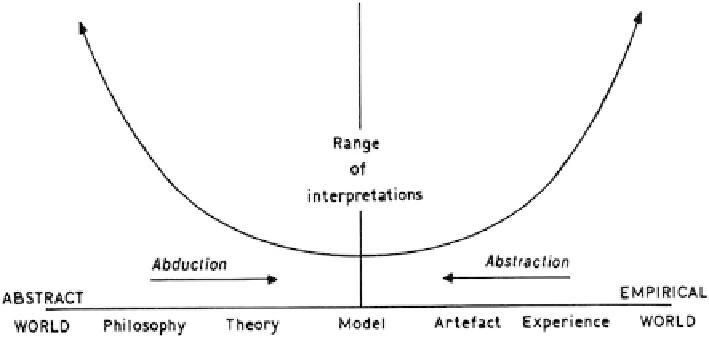Information Technology Reference
In-Depth Information
Fig. 10.5
The Model as a point of contact between theory and Artefact
A precise relationship between a theory and a model cannot be easily defined as
they both represent a range of possible interpretations and share many of the same
properties (cf. Aris
1978
). There is a continuum of theories or models ranging from
the non-specific (most general) to the identification of unique cases. The relationship
between a theory and a model is that a model will be associated with a more specific
situation (a case) than a theory. The complete range of models derivable from a
theory will be called the 'extension' of the theory. The theory from which a model
is derived is called its 'intension'.
Figure
10.5
illustrates the model as the end-product of several stages of abduction.
The model emerges from the potentially infinite set of possibilities that may be
presumed to exist within the abstract world of the human imagination. However,
the model is also the end-product of several stages of abstraction of the potential
distinctions in the empirical world. The model captures only a subset of the possible
features of an artifact. In the above case, it does not show the color, texture, smell
or structure of the materials; it's a coherent subset, which serves our purpose. A
model and a theory both together encapsulate an understanding of the world that is
the result of purpose and experience. A model and its associated theory will be called
'declarative knowledge' if the model relates to at least one feasible artifact (i.e. can
be constructed). What is feasible and the methods used to make such a judgment,
such as the comparison of predictions with observations, are referred to as 'inductive
inference' or just 'induction'.
In the case of the slide, the mathematical model will describe the active forces
of interest provided the right combination of calculations is applied. The knowledge
of how to perform a particular chosen calculation correctly is 'deductive inference'
or just 'deduction'. Mathematical calculations are deductive in the sense that they
are 'valid' operations and truth preserving. The understanding of how to perform
the three forms of inference; abduction, deduction and induction will be called
'inferential knowledge'.

